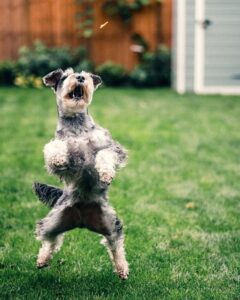The economics of behavior!
The Cost of Behavior
As cool as Freestyle and Rally-FrEe are, they can also be challenging sports for both dog and handler. We ask our dogs to stay engaged while training complex behaviors and while putting those behaviors into longer sequences and routines. That’s a proper challenge! It’s no wonder our efforts to keep our dogs motivated can sometimes fall flat.
We often talk about the importance of giving our dogs a decent paycheck. What does that mean exactly? And who determines that wage? Not all behaviors are created equally; there are cheap behaviors and there are expensive behaviors.
What is an “expensive behavior”?
Expensive behaviors are ones that take more of your dog’s effort! The greater the requirement for precision and accuracy, the more expensive. The longer the chain or sequence of behaviors, the more expensive.
Which behaviors are expensive are different for different dogs, but in general, the more complex they are, the more expensive they are. Heeling is an expensive behavior. Tight sequences where the dog needs to respond quickly to cues are expensive.
Expensive behaviors require a higher level of reinforcement in both quantity and quality.
Increasing the Value of your Rewards
It’s easy to get into a reward rut. We tend to reward the same way, with the same thing, in the same amount. Often, it’s with a single piece of food, then onto the next rep. Consider how much more our dogs would enjoy their work if the pay was commensurate with the work they did. Our dogs are a primary part of our performance! Without their commitment and desire to work with us, there is no routine! There is no Rally-FrEe run!
Instead of a cursory treat and a bit of praise without regard to what we are asking of our dogs, consider the dog’s perspective. Think of your rewards as “events”. Something the dog can find joy in! Something that makes it worth his while to stay engaged in the process!
A few ideas for rewarding expensive behaviors:
- Several treats in a row!
- An extra long game of tug!
- Several ball throws rather than just one!
- A game of chase and some food bowling!
Having your reward last longer provides your dog with a bit of respite from the hard work (and that, too, can be reinforcing)!
Your Next Steps for Success
Balancing which kinds of behaviors you include in your routines and rewarding your dog with more than a “living wage” can mean the difference between having a dog that looks forward to going to work and a dog that is happier collecting unemployment benefits.
At your next training session, don’t take your dog’s willingness to work hard for granted. In rewarding, consider the cost of behavior, the sequence, the new skill, the difficult environment. Recognize, too, how hard your dog works for something that is your goal, and not necessarily his.
Better rewards, stronger bonds, and more fun for all!

Make reward events fun and fulfilling for your dog, and you’ll have a happy training buddy!
